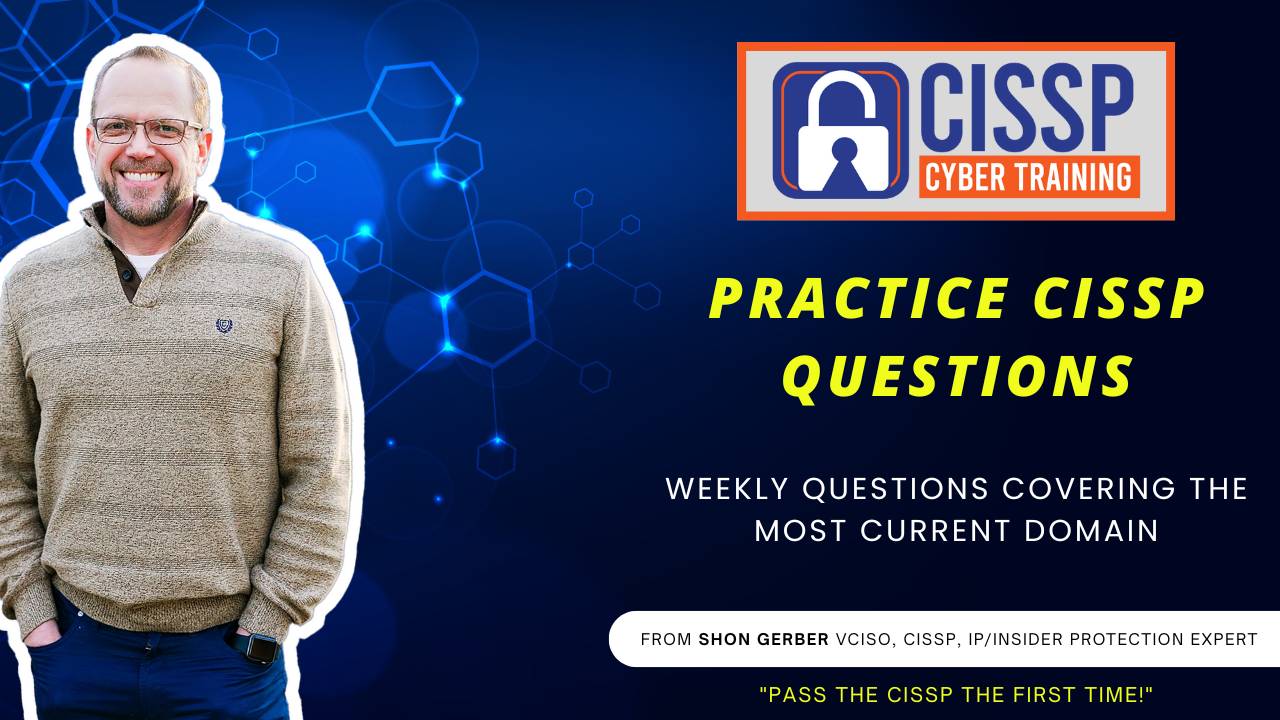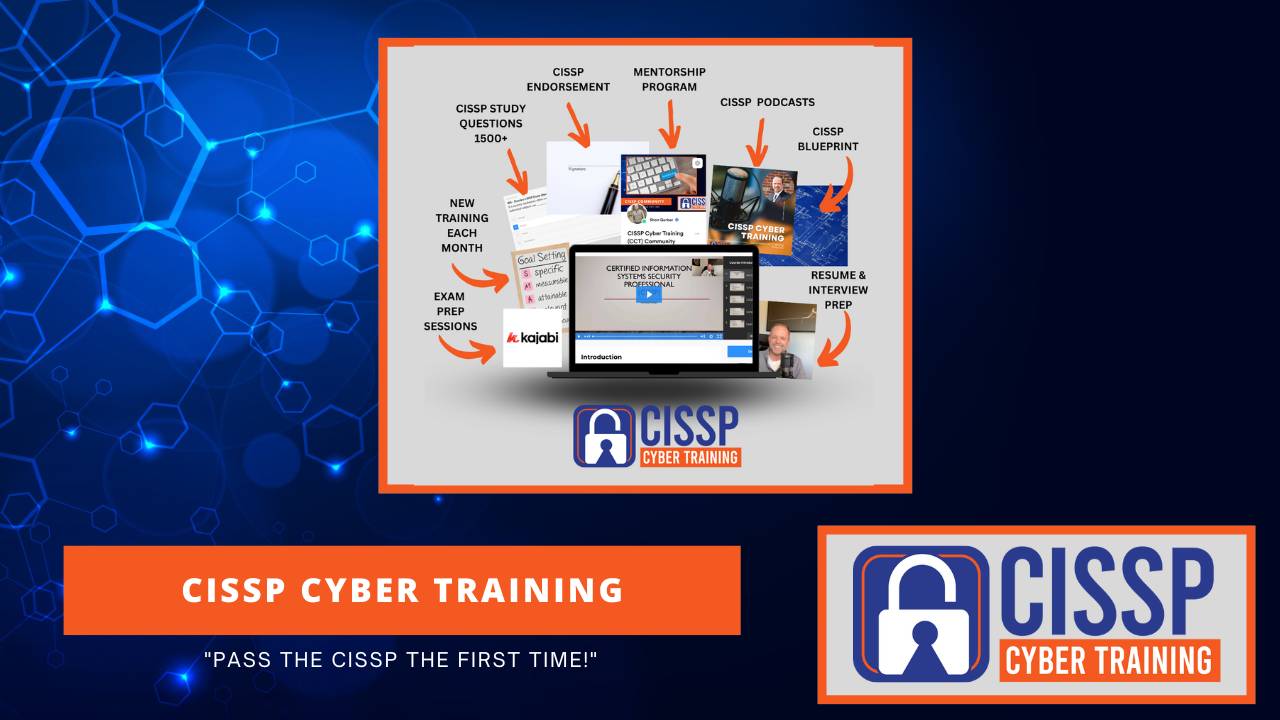CCT 061: Security Assessment, Audits, and Pen Testing - CISSP Exam Questions (Domain 6)
Aug 10, 2023Welcome to the CISSP Cyber Training Podcast, where we provide you the training and tools you need to pass the CISSP exam the first time. Hi, my name is Sean Gerber and I'm your host for this action-packed, informative podcast. Join me each week as I provide the information you need to pass the CISSP exam and grow your cybersecurity knowledge. All right, let's get started. Hey all of you, I'm Sean Gerber with CISSP Cyber Training, and today we're going to be having some various CISSP questions for you to help you pass the CISSP exam. Before we get started, you want to go to CISSPcybertrainingcom and you can get access to all of these CISSP questions. All you have to do is just sign up for my email list and you can get access to 30 free CISSP questions every single month. If you like that, you can try before you buy. If you like that, then you can get access by purchasing my membership or one of the other programs we have and you can get access to all of my CISSP questions. It's awesome, it really is. There's my recorded content. You name it. You can get it through CISSPcybertrainingcom. Let's start talking about CISSP questions and let's get on with question number one. We're going to be focused on domain six and of this domain, six. You can actually also see these at my podcast at CCT061. You can get these videos on YouTube and you can get them through CISSPcybertrainingcom. Which of the following is a primary objective of security assessments and testing A ensuring compliance of legal regulations. Two identifying vulnerabilities and weaknesses. C actually, there should have been two. There should have been B. C establishing incident response procedures. D developing security policies and procedures. Which of the following primary objectives of a security assessment and of testing A ensuring compliance with legal regulations. B identifying vulnerabilities and weaknesses. C establishing incident response procedures or D developing security policies and procedures? When you're dealing with security assessments and the testing, the ultimate goal is to get your vulnerabilities and find your weaknesses. Therefore, the answer would be B. Each of those other areas compliance, incident response and security policies are beneficial for a security assessment program, but they're not the primary objective for them. What is the purpose of validation strategies in security assessments and testing? Again, what is the purpose of validation strategies in security assessments and in testing? A to ensure compliance with regulatory requirements. B to assess the effectiveness of the security controls. C to evaluate the accuracy of the test results. Or D to define the scope of the testing activities. Okay, the purpose of the validation strategies? Basically, you're validating the security assessment and its test is B to assess the effectiveness of the security controls. Again, that's designed to basically identify unknown vulnerabilities by simulating real world attacks. If you want to basically validate that, you need to determine if it was effective or not. Which assessment methodology is best suited for identifying known vulnerabilities in a system? Again, the question is which assessment methodology is best suited to identify unknown vulnerabilities within a system A vulnerability scanning, b penetration scanning, c security auditing or D risk assessments? Okay, so which assessment methodology is best suited for identifying unknown vulnerabilities? And the answer would be penetration testing. Again, it's specifically designed to identify unknown vulnerabilities by simulating real world attacks. Question four what is the essential consideration when creating test data for security assessments? So, again, what is the essential consideration when creating realistic test data for security assessments? A including live production data. B using sensitive customer information. C maintaining data confidentiality. Or D avoiding anonymization techniques. Okay, so what is the essential consideration when creating realistic test data for security assessments? So, you're wanting to make sure that you create this realistic test data, but what is the purpose behind it, or main consideration that you wanna do it, when you're adding this data, this test data, to it. So you're grabbing data and you're putting it in there to basically run and see if it works. What is the main consideration you need to keep in mind? And that would be C maintaining data confidentiality. Okay, so you've got using sensitive customer information. That would be an essential consideration. You wouldn't wanna do that. You also, including live production data, may not wanna do that either. And then avoiding anonymization techniques. You want to anonymize the data, right? So if you're gonna be testing, so you wouldn't want that either. The main part that you're dealing with is data confidentiality. That is a bigger, broader brush than just using sensitive, than mentioning sensitive customer data. So that's a kind of a tricky one because you may bite off on the sensitive customer information, but the real answer is maintaining data confidentiality. Question five which of the following is a critical step in the audit process for security assessments and testing? A identifying vulnerabilities, b conducting penetration testing, c engaging external auditors or. D implementing remediation measures? Again, which of the following is a critical step in the audit process for security assessment and testing? A identify weaknesses. B conduct penetration testing. C engage external auditors. And D is implement remediation measures. So again, the question coming down to is a critical step in the audit process. That would be engaging external auditors. So usually having an external auditor and you're dealing with auditing is an important factor. You can do that for internal, but you would want a third party or a third group to do that internally for yourselves. Question six what is the primary purpose of continuous improvement in security assessment and testing? A identifying vulnerabilities and weaknesses, b ensuring compliance with legal regulations, c enhancing the effectiveness of assessment processes or. D developing security policies and procedures? Okay, again, the question was a primary purpose of continuous improvement in security assessment and testing A identifying vulnerabilities and weaknesses, b compliance and regulations. C enhancing the effectiveness of assessment processes or. D developing security policies and procedures. The primary purpose of continuous improvement is C enhancing the effectiveness of assessment processes. Again, continuous improvement aims to enhance the effectiveness of your security assessment and testing over time. Question seven what is a common validation objective in security assessment testing? A compliance with legal regulations. B as accuracy of assessment documentation. C alignment of industry standards or. D development of risk plans, risk mitigation plans. Again, what is a common validation objective in security assessment and testing? And the answer would be compliance with legal regulations, the one of the main purposes of a security assessment and the testing that goes with it is to help you come in line with compliance around legal regulations that might be out there. Depending on the industry you're in, you may have to have various audits or assessments done to ensure that you will comply with those legal regulations. One would be data security law with China. There would be ones with in the United States. Is your PCI DSS? All of those fall within that environment. Question eight which audit strategy develops an unbiased evaluation of an organization's a security posture? A internal audits, b external audits, three three C third-party audits or D compliance audits. Again, which is an unbiased evaluation of the organization's security posture? And the answer would be C third-party audits. They do typically provide an unbiased evaluation of your organization's security structure. An external audit might be somebody you actually work with you maybe you know them. That would be a situation where that might not be as unbiased as you possibly might like. Okay, question nine. Well, before we get into question nine, just wanted to again put out a plug for CISSP cyber training. Go check it out. You can also go to freecisspquestionscom and you can get access to my 30 free CISSP questions every single month for the next year. I mean you'll get them 360 questions to help you. That's 30 free CISSP questions at freecisspquestionscom. Question nine, which are the following examples of an external audit in security assessments and testing A self-assessment of internal auditors. B review the security policies by management. C an assessment conducted by an independent consulting firm. Or D evaluation of control effectiveness by the IT department. So which of the following is an example of an external audit in security assessment and testing? So, again, external audit. And the answer is C an assessment conducted by an independent consulting firm. If you look at the rest of the questions, you have to deal with internal auditors, you have management and you have the IT department. That is not typically an external audit. An independent consulting firm would be an external audit. Question 10, what is a recommendation approach? A recommended approach for addressing identified vulnerabilities in security assessments? So you have a security assessment, you find some vulnerabilities. How should you address those? A ignore low severity vulnerabilities. B prioritize vulnerabilities based on severity, conduct an additional assessment for confirmation. Or D focus solely on technical controls. Now, if you want, read through these, they'll make kind of sense right. So you definitely want to deal with severity and? But ignoring anything is usually not good. I mean, there might be a time you might do that, but typically isn't something you would do. You really don't need to. Once you've just conducted an assessment, you don't need to do another one, unless you really want to just spend money. So the answer would be be prioritizing violent vulnerabilities based on severity. So again, that's the recommended approach for identifying vulnerabilities in security assessments is to prioritize them Based on the severity and then address them as needed. Question 11 which aspect of a security assessment and testing should be continuously updated to reflect emerging threats? A test plans and procedures. B regulatory compliance requirements. C security control documentation or D audit reporting templates? So again, which aspect of the security assessment and the test should continuously be updated to reflect emerging threats? When you're basically testing your plans and procedures, that's, the threats will change, right from ransomware to a Worm that may roll in to different. You may have a stray backhoe that hits out, takes out your network. Those are different. So you may have different test plans and procedures and you may modify those to meet these emerging threats. Next question what is the purpose, purpose? What is the purpose of a performance evaluation in security assessments and testing? A Assess the effectiveness of the controls. B monitor the progress of the remediation activities. C evaluate the competence of the individuals individuals involved in the assessment. Or. D Validating compliance with regulatory requirements. So, again, what is the purpose of performance evaluations? Again, you're doing a review of the person in a security assessment and testing you both. The purpose of that is that you are evaluating their competence in what they're doing. So it would be answer would be C. So that's the ultimate goals that you are trying to figure out Are they the person that will actually understand what they're doing and are they capable of doing it? Question 13, which of the following is used to validate effectiveness controls during a security assessment testing Question? What is the question? What is the method is used to validate the effectiveness of controls during security assessments and testing? A Penetration testing be risk assessments. C Security auditing or Devulnerability scanning skin. Which method is used to validate the effectiveness of controls during a security assessment and testing? Yes, or the answer is C security auditing. Right, security auditing is a way to evaluate the effectiveness of the controls during a security assessment and a test. Question 14, how can collaboration and knowledge sharing contribute to continuous improvement in security assessments and tests? A facilitating the exchange of ideas and experiences. B reducing the need for external audits. C streamlining the assessment process. Or D minimizing the need for remediation efforts. So the question is again how can collaboration and knowledge sharing contribute to continuous improvement in security assessments and testing? Answer is A facilitating the exchange of ideas and experiences. That is basically how, when you share ideas, you get better ideas on how to deal with things. As an example, I met with some people in our local community and started sharing some ideas on ransomware and how it may affect the community, and they are taking that advice and they're moving on with it. So there's different ways. By sharing information can really go a long ways in protecting facilities or protecting anybody in general. Alright, question 15, the last question, the last melon which of the following is a key benefit of external audits in security assessments and testing? So, again, what is a key benefit of an external audit in security assessments and testing? A assurance of regulatory compliance. B identification of all vulnerabilities. C cost effective assessment procedures or D objectivity and impartiality. Again, what is the question is which of the following is a key benefit of an external audit in security assessments and testing? A insurance regulations assurance of regulatory compliance. B identification of all vulnerabilities, c cost effective assessment processes or D objectivity and impartiality. And the answer would be D objectivity and impartiality are one of the key benefits of having an external audit. Okay, I hope you all liked this. This was 15 questions of the CISSP. Go out to cisspcybertrainingcom and you can get some more. Sign up for at free cisspquestionscom and you can get a plethora of CISSP questions to help you study for the exam. Again, the ultimate goal is to help you pass this doggone exam. We want you to get through it, we want you to do well and we want you to move on with your cybersecurity career. All right, have a great day and we'll catch you on the flip side, see you.
CISSP Cyber Training Academy Program!
Are you an ambitious Cybersecurity or IT professional who wants to take your career to a whole new level by achieving the CISSP Certification?
Let CISSP Cyber Training help you pass the CISSP Test the first time!





